This article will explain what Gamification actually is, describe its advantages and potential risks based on scientific studies, tell you about its underlying psychological principles, and show several examples of its successful use in client- and employee-facing environments. In addition, the article includes a few pieces of advice on how to approach your own gamification strategy.
As one of the experienced elearning software development companies, we specialize in creating comprehensive eLearning solutions tailored to your needs, with the potential to integrate advanced gamification capabilities.
These can range from simple elements like badges to complex features such as branching scenarios, immersive interactions, and AR mini-games. Our team is skilled in crafting visually engaging designs that promote interactivity, and we can incorporate real-time performance analysis tools for immediate feedback.
We have the expertise to develop AI chatbots for enhanced interaction and can design mobile-friendly solutions for convenient learning on-the-go. Our capabilities include creating custom learning management systems with features like complex workflows and personalized learning paths, along with a sophisticated system for calculating achievement points. We can also enrich the learning experience by integrating a variety of gamification elements, including storytelling, points, leaderboards, and rewards, ensuring a comprehensive, engaging, and effective learning journey.
What is Gamification
Gamification is defined as the application of game elements in a non-game activity or environment. It is sometimes confused with a different approach called “game-based learning” - using play to achieve specific educational outcomes.
For example, giving an app user a badge as a reward for studying 10 days in a row is gamification. Playing a word game to expand foreign language vocabulary is game-based learning.
Both concepts have been in use for hundreds of years: ancient and medieval commanders played chess to prepare for war, Boy Scouts received badges to reward mastery of certain skills and even lion cubs develop their hunting skills by playing with each other. Today gamification and game-based learning are used at schools, Fortune 500 businesses, and even the military.
Benefits and Risks
A research team from the University of Tampere, Finland, analyzed the existing studies on the effect of gamification in learning and found that “the results reported in the reviewed studies are strongly positively oriented,” although not without certain caveats (more on that later).
Benefits
1. Learning effectiveness
Gamification leads to improved learning outcomes, as evidenced by a number of examples.
As part of an experiment by the University of Alcala, researchers have introduced a gamification system to the “Qualifications for users of ICT” course. This system included a leaderboard, personal stats, 36 challenge achievements, and 7 participation achievements. The students who have got at least 6 of those “got significantly higher final scores” than their counterparts who have used the non-gamified version.
In addition, digital learning didn’t stand in the way of the real-world study: “there is no evidence that can confirm that the gamified experience yields worse results in written examinations or somehow prevents students from participating in class activities”.
Another study showed that the group participating in a gamification experiment was much more successful in completing exercises without mistakes, although the overall test scores were only marginally above the control group. However, the authors of the paper point out that the grades tell only part of the truth, as they don’t measure knowledge retention or transfer of learned skills.
2. Increased Motivation
Studies show that gamification increases people’s desire to learn.
In the experiment by the University of Aalto researchers, 74% of the participants reported increased motivation: “I got a feeling like in a car game. It was funny how much I wanted to unlock them (the badges - author).” This was supported by fact that the students in the gamified group spent more time studying: 13.4 hours compared to 11.4 hours in the control group. An almost 15% increase is nothing to sneeze at.
Interestingly enough, the badges which were given for early turn-in of the assignments were somewhat successful in dealing with traditional student procrastination.
Another analysis of published studies on gamification also noted that people were more motivated to learn when there were game elements involved.
3. Fun
While it is hard to quantify people’s enjoyment, it can and does have demonstrable results.
Folding virus proteins is not what most people would consider doing in their spare time. But when turned into a game, it can yield extraordinary effect: using Foldit the enthusiastic gamers were able to solve a problem that has puzzled biochemists for 15 years. It took the players just three weeks.
The analysis of studies that we’ve mentioned above, also notes that all of the papers reported increased engagement and enjoyment.
Risks
Gamification is not a one-size-fits-all approach, which is the root of most of the risks present in its implementation.
1. Requires buy-in by learners
In some cases, introducing game elements only made their results worse.
Professor Ethan Mollick from Wharton conducted a study on “Slam-Dunk” - a basketball-themed sales game that rewarded players for cold calling, closing deals, getting leads, and other sales activities. The research showed that while it was beneficial for many participants, some were turned off by it and even suffered a hit to their KPIs.
The difference was in consent - players who actively embraced the game succeeded, while those who didn’t want to play got negative feelings towards their job and company. “Without consent — people’s sense of willingness and involvement in the game — a company is left trying to create “mandatory fun,” as Mollick put it.
2. Might give wrong motivation
This risk is twofold: firstly, what you thought to be encouraging to the learners might actually have the opposite effect. Secondly, the motivation to learn might be replaced by the desire to simply earn more badges or get a higher position on the leaderboard, which will hamper knowledge retention.
In the previously mentioned study by the Aalto University researchers, the “early bird” badges caused students to move from turning in assignments right before the deadline to frantically completing them as soon as possible, even before the topics were introduced in class.
The badge for completing an assignment without errors on the first try also wasn’t the best motivator for careful study because “once the first mistake is made, the badge is lost and no longer offers an incentive to avoid resubmissions”.
In each of these examples, the authors note that a more careful approach to the badge condition is needed to stimulate the desired behavior.
Other researchers point out that points and badges can be a shallow attempt at giving learners extrinsic motivation. The focus shifts from the learning outcome towards earning the rewards and knowledge retention suffers as a result.
3. More information is needed
Compared to some other fields, there was relatively little research done on gamification. Prof. Jonna Koivisto stated that she analyzed about 800 studies on this topic, but only 300 of them were based on empirical information. As such, “we can’t very confidently say much of anything about what works and what doesn’t”.
How Does Gamification Work
This approach is based on human psychology and works in three ways.
1. Goal-setting
A badge, a level, a position on a leaderboard - these are visible and attainable goals. As a result, the learners set their expectations higher (this gives a stronger motivation to achieve them) and increased performance. Moreover, reaching your goals is satisfying, which pushes people towards new achievements.
As a side effect, there is completionism - in the study by the Aalto University researchers, many students worked towards 100% grade, even though 90% was enough. As the authors point out, getting the maximum result could be gamification in itself - each percent is a point.
2. Social interaction and competition
Humans inherently want acceptance by others of our kind and recognition of their worth. Social aspects of the gamified environment, like a leaderboard, or an open profile that proudly displays the user’s achievements, directly appeal to both of these motivators which have a proven effect on the effectiveness of learning.
Competition is a bit more tricky in this regard. Some people are naturally drawn to it, so they strive to get to the top of the leaderboard. Others are okay with just getting on the least of the best learners. Still others are discouraged by it.
As stated previously, this matter greatly depends on the context.
3. Usefulness and Ease of use.
When a user finds that a system is enhancing their performance (“perceived usefulness”) and is obstacle-free (“ease of use”), it increases the value of that system. A well-gamified educational program fits both of these criteria and causes learners to spend more time in it.
Popular Gamification Methods
There are many game-design elements that can be used in an e-learning environment. We will list the five most widespread ones. Note that the users shouldn’t lose their hard-earned rewards - this can be very demotivating.
Points
When a learner completes an assignment, they receive a certain number of points as a reward. They present an understandable benchmark to gauge a user’s progress.
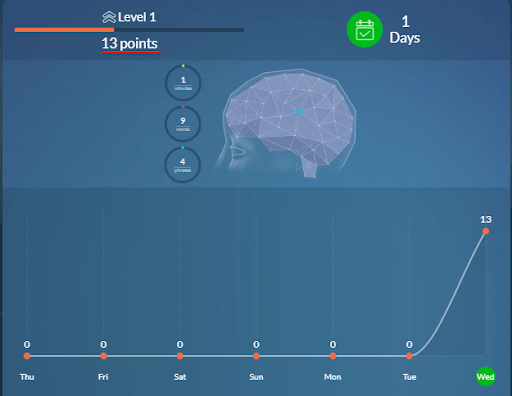 Points in Mondly - a language-learning application.
Points in Mondly - a language-learning application.Leaderboard
A leaderboard appeals to our need for status and social acceptance. It can also be very motivating for the naturally competitive learners.
This feature should only be used for positive reinforcement - “loserboards” are very demotivating.
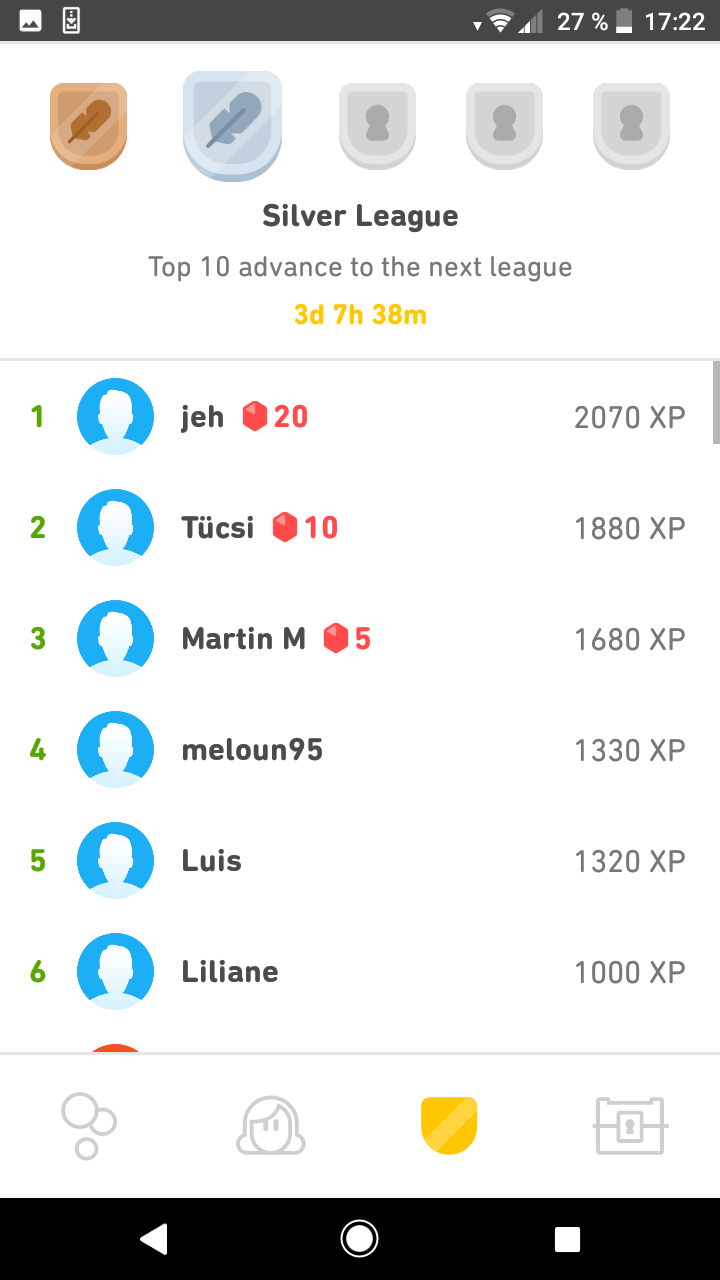
Leaderboard in Duolingo - a language learning app. Source
Achievement Badges
To reward a specific behavior, like continuous study or careful preparation, a user might be awarded a badge to commemorate their achievement.
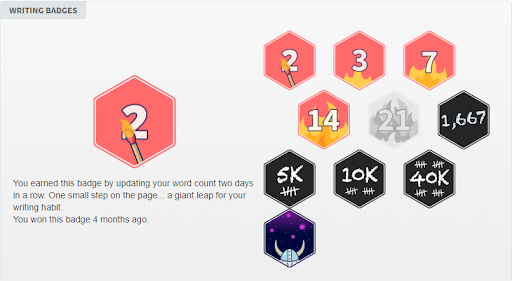 Badges in NaNoWriMo - a platform for aspiring writers
Badges in NaNoWriMo - a platform for aspiring writersLevels
In a role-playing game, a character can gain experience and increase their level. The same approach can be applied to a user in eLearning software. For example, a hundred points are enough to reach level 2. The levels can be used to scale the challenge difficulty to fit the learner, as well as serve as a demonstration of the user’s skills and persistence.
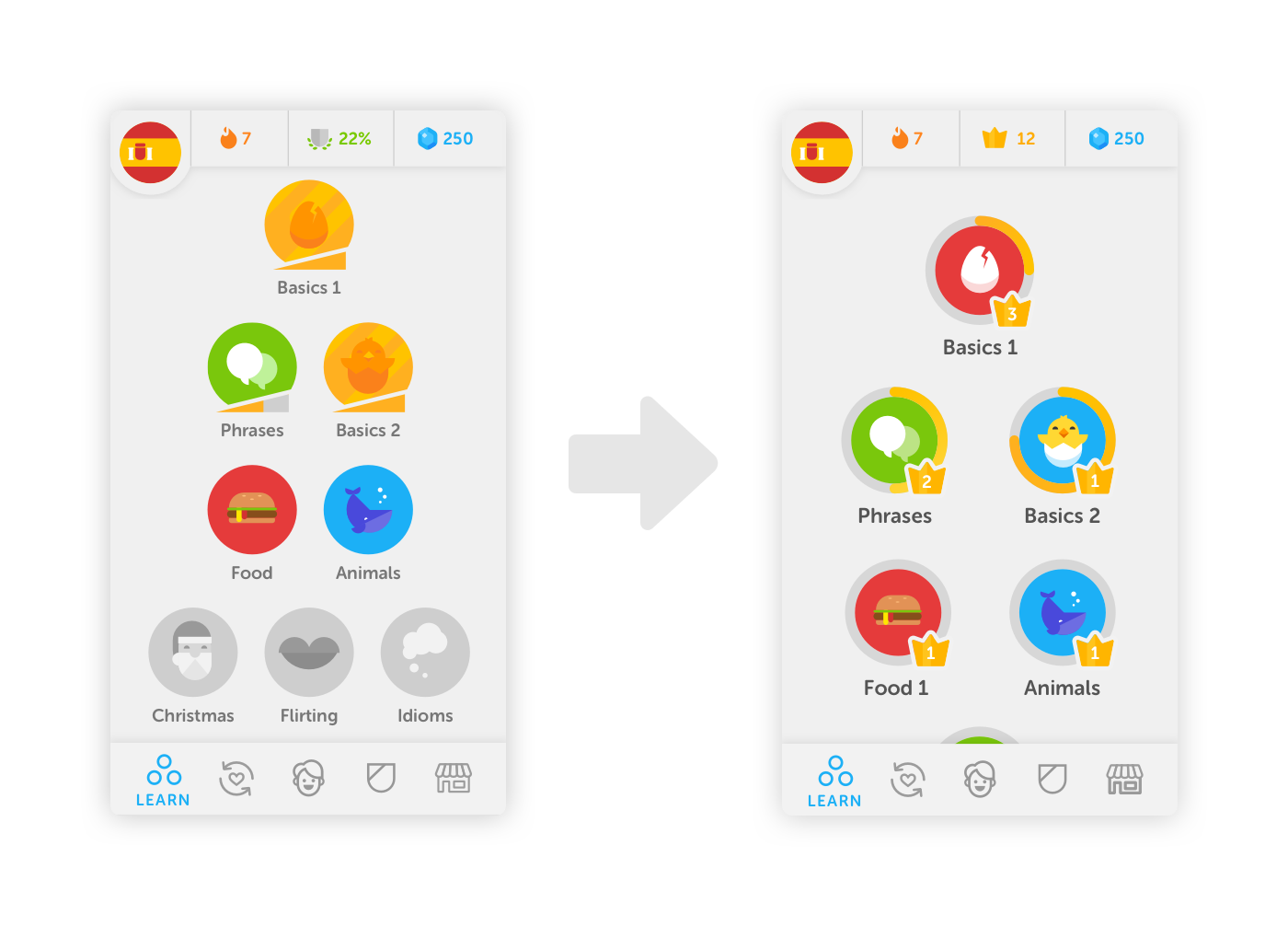
Levels in Duolingo - the crowns denote the level of a specific skill. Source
Story
Adding a narrative increases a user’s motivation. This can be something as simple as launching a rocket to the moon, with each step bringing the learner a bit closer to success, or an elaborate story with conflict, setting and 3-dimensional characters.
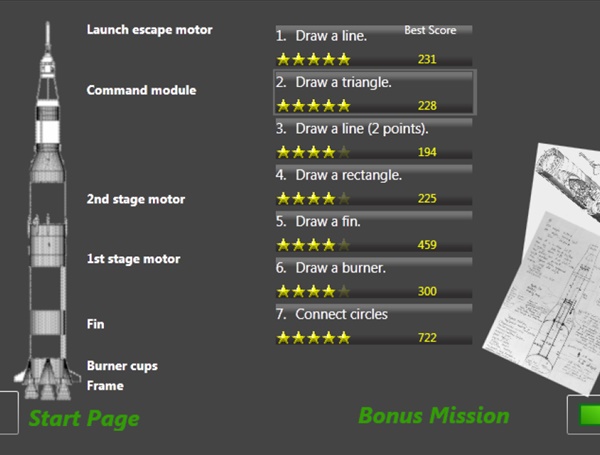
GamiCAD - gamified tutorial for AutoCAD users. Source
Gamification in Practice
There are many companies that successfully use gamification to improve the outcomes for internal and external users alike.
Ticken
Ticken is an innovative touch-typing course developed by Belitsoft for a Dutch serial entrepreneur Martin Beijer. It utilizes a unique training method and a simple, yet effective gamification system to get ahead of the competitors.
As a result, a learner needs only 15 hours to raise their typing speed to 140 characters per minute, and 98% of the users pass the final exam on the first try. Since its launch in 2010, more than 100.000 people bought the course and the average user rating is still at 8,6/10.
The gamification suite in Ticken includes a progress bar so the users can see their progress in the exercise, a leaderboard, and seven learning games to improve knowledge retention.
For more information on Ticken see this case study.
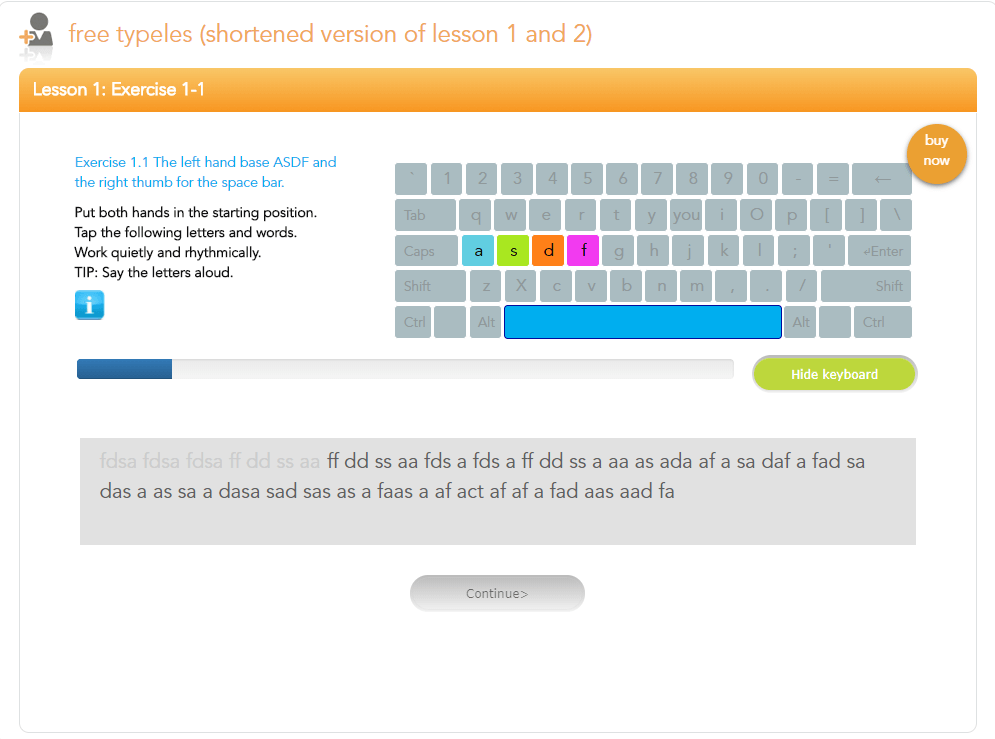
Duolingo
Duolingo is one of the most popular language-learning apps in the world with over 200 million users and dozens of available languages. Gamification is one of its core advantages and a major factor in its success, as stated by Zan Gilani, its product manager.
The relevant features include but not limited to:
- Points that also double as in-app currency. They can be spent on purchasing cosmetic items for the mascot or special bonus lessons.
- Achievements that reward learning streaks, social interaction, lesson completion, etc.
- Leaderboards separated by language, location, friends group, etc.
- Levels to display the user’s skills in specific areas of their chosen language.
- Mascot that provides support, motivation, and meme potential.
For a more detailed analysis of the Duolingo see this article.
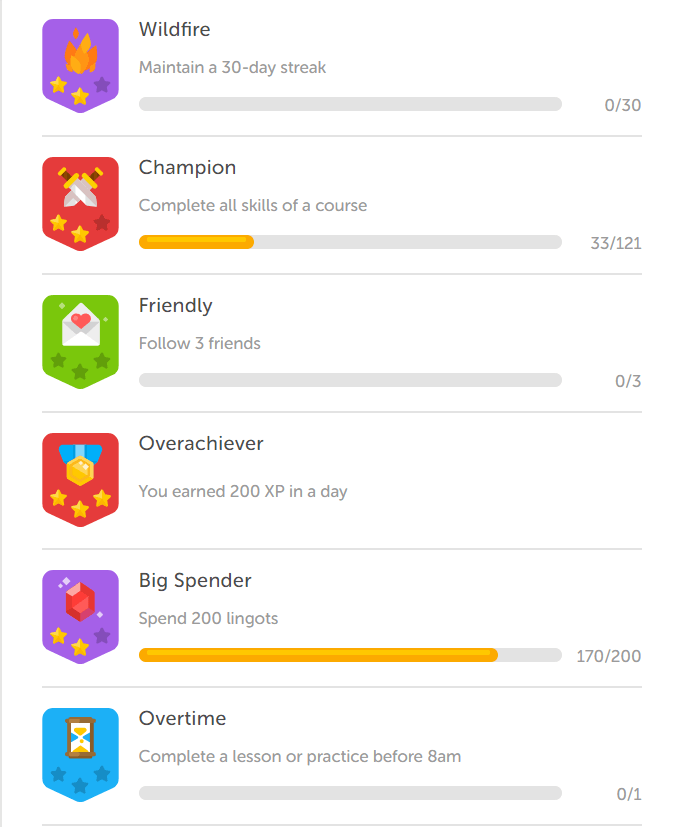 Achievements in Duolingo
Achievements in DuolingoDeloitte Leadership Academy
Deloitte, one of the four largest accounting and auditing firms in the world, has found out that leadership can literally make or break companies: good leadership adds 15% to valuation in the eyes of the investment consultants, while bad one reduces this number by 20%. So it is no wonder that Deloitte themselves have an advanced leadership training program.
It was a powerhouse already, with courses from institutions like Harvard, Stanford, and Melbourne Business School. But gamification has made it even more attractive: in five years since its inception in 2008 it had over 20.000 users with a 37% increase in returns to the site after the game elements were added.
The gamification methods used in Deloitte Leadership Academy include
- Badges.
- Adaptive leaderboards. There is a separate leaderboard for each general “level” of user, so that they can compete in their own weight class. Moreover, the results are reset each week, so everyone has a chance to get to the top and no one would miss out if they have to take a break (a vacation or a sick leave, for example).
- Personalization. The user’s profile can be modified and connected to their Twitter and LinkedIn profiles to improve engagement.

Deloitte Leadership Academy. Source
How to Gamify Well
Professors Armstrong and Landers, who have hands-on gamification experience, suggest starting with a tried and true ADDIE:
- Assess the needs
- Design
- Develop
- Implement
- Evaluate.
The first step should be finding the pain points that gamification needs to address. When the problems are identified and the goals are set, you will have a direction that your program needs to take. It may also drive you to other methods of improving your eLearning process.
Deloitte experts recommend adapting your strategy to the player types you have in your company. Depending on your corporate culture, you may attract different personalities that have different motivations: some enjoy exploring content, others like competition, still others want to achieve 100% in everything.
A Harvard Business Review contributor and an HR company partner Jeanne C. Meister advises to set up a plan for tracking the effectiveness of your gamification. Set up KPIs (engagement level, completion rate, etc.), the benchmarks and the means to analyze whether the program is achieving the desired results.
Rate this article
Recommended posts
Portfolio
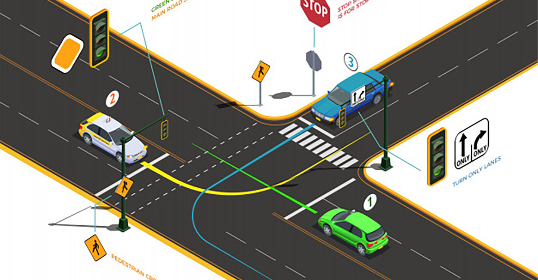
Our Clients' Feedback






















.png)
.jpg)
.jpg)
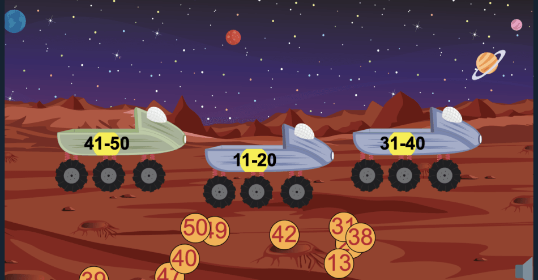












Belitsoft has been the driving force behind several of our software development projects within the last few years. This company demonstrates high professionalism in their work approach. They have continuously proved to be ready to go the extra mile. We are very happy with Belitsoft, and in a position to strongly recommend them for software development and support as a most reliable and fully transparent partner focused on long term business relationships.
Global Head of Commercial Development L&D at Technicolor